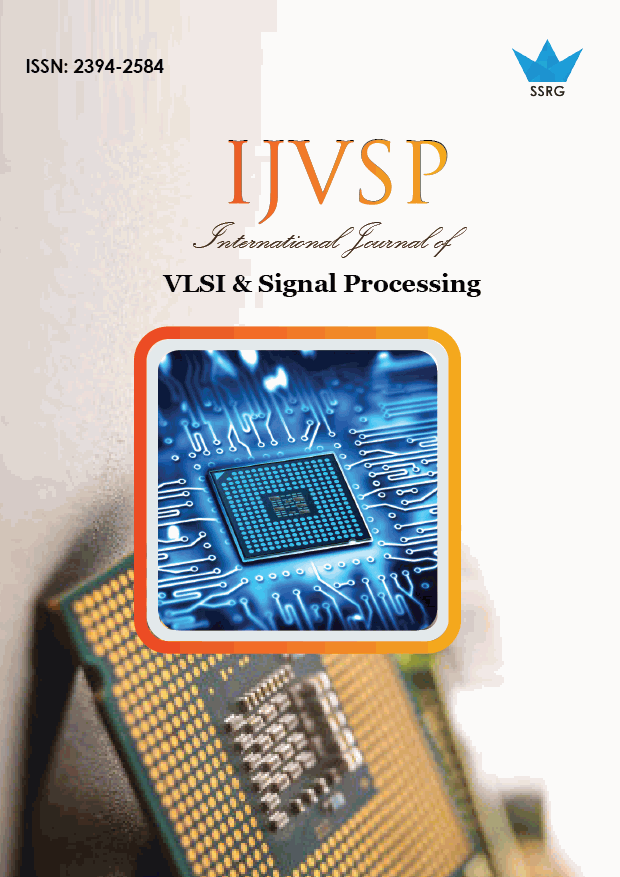A Review on Low Power Memory Design Technique

| International Journal of VLSI & Signal Processing |
| © 2019 by SSRG - IJVSP Journal |
| Volume 6 Issue 3 |
| Year of Publication : 2019 |
| Authors : Bhumika Chaurasia, Nishi Pandey, Meha Shrivastava |
How to Cite?
Bhumika Chaurasia, Nishi Pandey, Meha Shrivastava, "A Review on Low Power Memory Design Technique," SSRG International Journal of VLSI & Signal Processing, vol. 6, no. 3, pp. 10-13, 2019. Crossref, https://doi.org/10.14445/23942584/IJVSP-V6I3P103
Abstract:
This article describes the 10L Ultra Low Power Static RAM (ULP) for Internet Object (IoT) applications running below the threshold. The proposed SRAM, as a rule, operate at low supply voltage with a high static and dynamic noise margin. IoT applications require a battery compatible low leakage memory architecture in the lower threshold region. Therefore, to improve leakage energy consumption and cell stability, this technical document presents the reliable SRAM 10T power system. The proposed cell uses a p-MOS transistor with a power system to reduce power leakage or static power in standby mode. Also, due to the overlapping of the n-MOS transistor in the 10T SRAM latch and the separation of the read path of the
10T SRAM latch, static and dynamic noise reserves in reading and write operations show significant tolerance. There are variations in the process
parameters, voltage and temperature (PVT) of the device. The proposed SRAM significantly improves leakage power, static noise reading (RSNM), static noise recording (WSNM), write capacity or write trigger point (WTP), read-write power and dynamic read field (DRM) show performance. Also, these parameters of the proposed cell are observed in 8 kilobits (KB) of SRAM and are compared with the existing SRAM architecture. Based on the Monte Carlo simulation results, it was found that the leakage power of the proposed low SRAM LVT 10T threshold is decreasing.
Keywords:
Memory design; Ultra power; Circuit design
References:
1] H. Morirnura, S. Shigernatsu, and S. Konaka, “Morirnura_2_A Shared-Bitline SRAM Cell Architecture for 1 -V Ultra Low-Power Word-Bit Configurable Macrocells,”pp. 12–17.
[2] H. Lee, “H. Lee_4_Design of ultra low power pseudoasynchronous SRAM,” Proc. - 12th Annu. IEEE Int. ASIC/SOC Conf., p. 275, 1999.
[3] O. Thomas, A. Amara, and A. Valentian, “Olivier_6_SOI partially-depleted ultra low voltage memory and digital circuit design,” IEEE Intemational Conf. Integr. Circuit Technol. SO1, pp. 211–215, 2005.
[4] D. Levacq, V. Dessard, and D. Flandre, “Levacq_7_Low leakage SOI CMOS static memory cell with ultra-low power diode,” IEEE J. Solid-State Circuits, vol. 42, no. 3, pp. 689– 701, 2007.
[5] M. Rahman, M. Li, J. Shi, S. Khasanvis, and C. A. Moritz, “16_A new Tunnel-FET based RAM concept for ultra-low power applications,” Proc. 2014 IEEE/ACM Int. Symp. Nanoscale Archit. NANOARCH 2014, pp. 57–58, 2014.
[6] W. Steve Ngueya, J. Mellier, S. Ricard, J. M. Portal, and H. Aziza, “1_An ultra-low power and high speed single ended sense amplifier for non-volatile memories,” Proc. - 2017 1st New Gener. CAS, NGCAS 2017, pp. 209–212, 2017.
[7] T. Kim, H. Kim, and Y. Chung, “20_Design of advanced subthreshold SRAM array for ultra-low power technology,” 2018 5th Int. Conf. Electr. Electron. Eng. ICEEE 2018, pp. 329–333, 2018.
[8] P. D. Schiavone, D. Rossi, A. Pullini, A. Di Mauro, F. Conti, and L. Benini, “21_Quentin: an ultra-low-power PULPissimo SoC in 22nm FDX,” 2018 IEEE SOI-3D-Subthreshold Microelectron. Technol. Unified Conf. S3S 2018, pp. 1–3, 2019.
[9] S. Y. Woo et al., “Synaptic device using a floating fin-body MOSFET with memory functionality for neural network,” Solid. State. Electron., vol. 156, no. March, pp. 23–27, 2019.
[10] Y. Ota and B. M. Wilamowski, “Analog implementation of pulse-coupled neural networks,” IEEE Trans. Neural Networks, vol. 10, no. 3, pp. 539–544, 1999.
[11] F. Moradi, D. T. Wisland, H. Mahmoodi, Y. Berg, and T. V. Cao, “11_New SRAM design using body bias technique for
ultra low power applications,” Proc. 11th Int. Symp. Qual. Electron. Des. ISQED 2010, no. 0316, pp. 468–471, 2010.
[12] D. E. Khodja, A. Kheldoun, and L. Refoufi, “Sigmoid function approximation for ANN implementation in FPGA devices,” Proc. 9th WSEAS Int. Conf. Circuits, Syst. Electron. Control signal Process., vol. 2, no. 1, pp. 112–116, 2010.
[13] J. Chen, K. S. Chong, B. H. Gwee, and J. S. Chang, “J CHEN_12_An ultra-low power asynchronous quasi-delayinsensitive (QDI) sub-threshold memory with bit-interleaving and completion detection,” Proc. 8th IEEE Int. NEWCAS Conf. NEWCAS2010, pp. 117–120, 2010.
[14] H. P. Rajani, H. Guhilot, and S. Y. Kulkanri, “Rajani_13_Novel stable SRAM for ultra low power deep submicron cache memories,” 2011 IEEE Recent Adv. Intell. Comput. Syst. RAICS 2011, pp. 489–492, 2011.
[15] N. Saini and G. Saini, “22_Spacer Engineered Junction-Less Transistor: A Device Circuit Co-Design Study for Ultra-LowPower Applications,” Proc. 2nd Int. Conf. Intell. Comput. Control Syst. ICICCS 2018, no. Iciccs, pp. 1445–1450, 2019.

 10.14445/23942584/IJVSP-V6I3P103
10.14445/23942584/IJVSP-V6I3P103